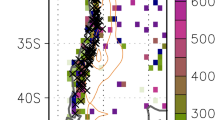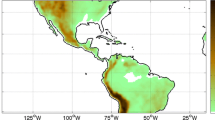Abstract
The present study aims at evaluating and comparing precipitation over the Amazon in two sets of historical and future climate simulations based on phase 3 (CMIP3) and 5 (CMIP5) of the Coupled Model Intercomparison Project. Thirteen models have been selected in order to discuss (1) potential improvements in the simulation of present-day climate and (2) the potential reduction in the uncertainties of the model response to increasing concentrations of greenhouse gases. While several features of present-day precipitation—including annual cycle, spatial distribution and co variability with tropical sea surface temperature (SST)—have been improved, strong uncertainties remain in the climate projections. A closer comparison between CMIP5 and CMIP3 highlights a weaker consensus on increased precipitation during the wet season, but a stronger consensus on a drying and lengthening of the dry season. The latter response is related to a northward shift of the boreal summer intertropical convergence zone in CMIP5, in line with a more asymmetric warming between the northern and southern hemispheres. The large uncertainties that persist in the rainfall response arise from contrasted anomalies in both moisture convergence and evapotranspiration. They might be related to the diverse response of tropical SST and ENSO (El Niño Southern Oscillation) variability, as well as to spurious behaviours among the models that show the most extreme response. Model improvements of present-day climate do not necessarily translate into more reliable projections and further efforts are needed for constraining the pattern of the SST response and the soil moisture feedback in global climate scenarios.















Similar content being viewed by others
References
Arora VK, Boer GJ, Christian JR, Curry CL, Denman KL, Zahariev K, Flato GM, Scinocca JF, Merryfield WJ, Lee WG (2009) The effect of terrestrial photosynthesis down regulation on the twentieth-century carbon budget simulated with the CCCma earth system model. J Clim 22:6066–6088
Betts RA, Cox PM, Collins M, Harris PP, Huntingford C, Jones CD (2004) The role of ecosystem–atmosphere interactions in simulated Amazonian precipitation decrease and forest die-back under global climate warming. Theor Appl Climatol 78:157–175. doi:10.1007/s00704-004-0050-y
Botta A, Ramankuttym N, Foley JA (2002) Long-term variations of climate and carbon fluxes over the Amazon Basin. Geophys Res Lett 29:564–579
Bretherton CS, Smith C, Wallace M (1992) An intercomparison of methods for finding coupled patterns in climate data. J Clim 5:541–560
Cook B, Zeng N, Yoon J-H (2012) Will Amazonia dry out? Magnitude and causes of change from IPCC climate model projections. Earth Interact 16:1–27
Cox PM, Betts RA, Jones CD, Spall SA, Totterdell IJ (2000) Acceleration of global warming due to carbon-cycle feedbacks in a coupled climate model. Nature 408:184–187. doi:10.1038/35041539
Cox PM, Betts RA, Collins M, Harris PP, Huntingford C, Jones CD (2004) Amazonian forest die-back under climate-carbon cycle projections for the 21st century. Theor Appl Climatol 78:137–156. doi:10.1007/s00704-004-0049-4
Cox PM, Harris PP, Huntingford C, Betts RA, Collins M, Jones CD, Jupp TE, Marengo JA, Nobre CA (2008) Increasing risk of Amazonian drought due to decreasing aerosol pollution. Nature 453:212–215
Dai A (2006) Precipitation characteristics in eighteen coupled climate models. J Clim 19(18):4605–4630
Douville H, Salas-Mélia D, Tyteca S (2006) On the tropical origin of uncertainties in the global land precipitation response to global warming. Clim Dyn 26:367–385. doi:10.1007/s00382-005-0088-2
Douville H, Decharme B, Ribes A, Alkama R, Sheffield J (2012) Anthropogenic influence on multi-decadal changes in reconstructed global evapotranspiration. Nat Clim Change. doi:10.1038/NCLIMATE1632
Foley JA (2002) El Niño–Southern oscillation and the climate, ecosystems and rivers of Amazonia. Global Biogeochem Cycles 16:1132. doi:10.1029/2002GB001872
Foley JA, Costa MH, Delire C, Ramankutty N, Snyder P (2003) Green surprise: howterrestrial ecosystems could affect Earth’s climate. Front Ecol Environ 1:38–44
Good P, Jones C, Lowe J, Betts R, Gedney N (2012). Comparing tropical forest projections from two generations of Hadley Centre Earth System models, HadGEM2-ES and HadCM3LC. J Clim. doi:10.1175/JCLI-D-11-00366.1
Joetzjer E, Douville H, Delire C, Ciais P, Decharme B, Tyteca S (2012) Evaluation of drought indices at interannual to climate change timescales: a case study over the Amazon and Mississippi river basins. Hydrol Earth Syst Sci Discuss 9:13231–13249. doi:10.5194/hessd-9-13231-2012
Kumagai TO, Saitoh TM, Sato Y, Takahashi H, Manfroi OJ, Morooka T, Kuraji K, Suzuki M, Yasunari T, Komatsu H (2005) Annual water balance and seasonality of evapotranspira- tion in a Bornean tropical rainforest. Agric For Meteorol 128:81–92
Lewis SL, Brando PM, Phillips OL, Van Der Heijden GMF, Nepstad D (2011) The 2010 Amazon drought. Science 331:554
Li W, Fu R, Dickinson RE (2006) Rainfall and its seasonality over the Amazon in the 21st century as assessed by the coupled models for the IPCC AR4. J Geophys Res 111:1–14
Li W, Zhang P, Ye J, Li L, Backer PA (2011) Impact of two different types of El Nino events on the Amazon climate and ecosystem productivity. J Plant Ecol 4(1–2):91–99. doi:10.1093/jpe/rtq039
Malhi Y, Roberts JT, Betts RA, Killeen TJ, Li W, Nobre CA (2008) Climate change, deforestation, and the fate of the Amazon. Science 319:169–172. doi:10.1126/science.1146961
Malhi Y et al (2009) Exploring the likelihood and mechanism of a climate-change-induced dieback of the Amazon rainforest. Proc Natl Acad Sci USA 106(49):20610–20615
Marengo JA (1992) Interannual variability of surface climate in the Amazon basin. Int J Climatol 12:853–863
Marengo JA (2004) Interdecadal variability and trends of rainfall across the Amazon basin. Theor Appl Climatol 78(1–3):79–96. doi:10.1007/s00704-004-0045-8. http://springerlink.metapress.com/openurl.asp?genre=article&id
Marengo JA et al (2008) The drought of Amazonia in 2005. J Clim 21(3):495–516
Marengo JA, Tomasella J, Alves LM, Soares WR, Rodriguez DA (2011) The drought of 2010 in the context of historical droughts in the Amazon region. Geophys Res Lett 38:1–5. doi:10.1029/2011GL047436
Meggers B (1994) Archeological evidence for the impact of Mega-El Niño events on Amazonia during the past two millennia. Clim Change 28:321–338
Phillips O, Aragão L, Lewis S et al (2009) Drought sensitivity of the Amazon rainforest. Science (New York, N.Y.) 323(5919):1344–1347
Potter C, Klooster S, Hiatt C, Genovese V, Castilla-Rubio JC (2011) Changes in the carbon cycle of Amazon ecosystems during the 2010 drought. Environ Res Lett 6:034024
Power SB, Delage F, Colman R, Moise A (2012) Consensus on twenty-first century rainfall projections in climate models more widespread than previously thought? J. Climate 25:3792–3809
Rammig A, Jupp T, Tietjen B, Heinke J, Ostberg S, Cox PM (2010) Estimating the risk of Amazonian forest dieback. New Phytol 187:695–707
Rayner NA, Parker DE, Horton EB, Folland CK, Alexander LV, Rowell DP, Kent EC, Kaplan A (2003) Global analyses of sea surface temperature, sea ice, and night marine air temperature since the late nineteenth century. J Geophys Res 108(14):4407. doi:101029/2002JD002670
Riahi K, Gruebler A, Nakicenovic N (2007) Scenarios of long-term socio-economic and environmental development under climate stabilization. Technol Forecast Soc Chang 74(7):887–935
Riahi K et al (2011) RCP 8.5 A scenario of comparatively high greenhouse gas emissions. Clim Change 109(1–2):33–57
Richey J, Nobre CA, Deser C (1989) Amazon River discharge and climate variability: 1903 to 1985. Science 246:101–103
Richter I, Xie SP, Wittenberg AT, Masumoto Y (2012) Tropical Atlantic biases and their relation to surface wind stress and terrestrial precipitation. Clim Dyn 38:985–1001
Rojas M, Seth A, Rauscher SA (2006) Relationship between precipitation and moisture flux changes in the SRES A2 scenario for the South American monsoon region. CLARIS News 3:14–20
Rudolf B et al (2011) New GPCC full data reanalysis version 5 provides high-quality gridded monthly precipitation data. GEWEX News 21(2):4–5
Seager R, Naik N, Vecchi G (2010) Thermodynamic and dynamic mechanisms for large-scale changes in the hydrological cycle in response to global warming. J Clim 23:4651–4668
Sellers PJ, Bounoua L, Collatz GJ, Randall DA, Dazlich DA, Los SO, Berry JA, Fung I, Tucker CJ, Field CB, Jensen TG (1996) Comparison of radiative and physiological effects of doubled atmospheric CO2 on climate. Science 271:1402–1406. doi:10.1126/science.271.5254.1402
Sombroek W (2001) Spatial and temporal patterns of amazon rainfall. Consequences for the planning of agricultural occupation and the protection of primary forests. Ambio 30:388–396
Uvo CRB, Repelli CA, Zebiak S, Kushnir Y (1998) The relationship between tropical Pacific and Atlantic SST and Northeast Brazil monthly precipitation. J Clim 11:551–562
Vera C et al (2006) Climate change scenarios for seasonal precipitation in South America from IPCC-AR4 models. Geophys Res Lett 33(13):2–5
Wallace JM, Lim GH, Blackmon ML (1988) Relationship between cyclone tracks, anticyclone tracks and baroclinic waveguides. J Atmos Sci 45:439–462
Wallace JM, Smith C, Bretherton CS (1992) Singular value decomposition of Wintertime Sea surface temperature and 500-mb height anomalies. J Clim 5:561–576
Wild M et al (2005) From dimming to brightening: decadal changes in solar radiation at earth’s surface. Science 308:847–850. doi:10.1126/science.1103215
Xu L, Samanta A, Costa M, Ganguly S, Nemani R, Myeni R (2011) Widespread decline in greenness of Amazonian vegetation due to the 2010 drought. Geophys Res Lett 38(7):2–5
Yoon JH, Zeng N (2009) An Atlantic influence on Amazon rainfall. Clim Dyn 34:249–264
Zeng N (1999) Seasonal cycle and interannual variability in the Amazon hydrologic cycle. J Geophys Res 104:9097–9106
Zeng N, Yoon JH, Marengo JA, Subramaniam A, Nobre CA, Mariotti A, Neelin JD (2008) Causes and impacts of the 2005 Amazon drought. Environ Res Lett 3:014002
Acknowledgments
The authors are grateful to Michael Coe for his helpful comments on the first draft of this article. Thanks are also due to the French Commissariat à l’Energie Atomique for supporting this study, as well as to Hervé Giordani for helpful discussion and to the anonymous reviewers for their constructive comments.
Author information
Authors and Affiliations
Corresponding author
Rights and permissions
About this article
Cite this article
Joetzjer, E., Douville, H., Delire, C. et al. Present-day and future Amazonian precipitation in global climate models: CMIP5 versus CMIP3. Clim Dyn 41, 2921–2936 (2013). https://doi.org/10.1007/s00382-012-1644-1
Received:
Accepted:
Published:
Issue Date:
DOI: https://doi.org/10.1007/s00382-012-1644-1




